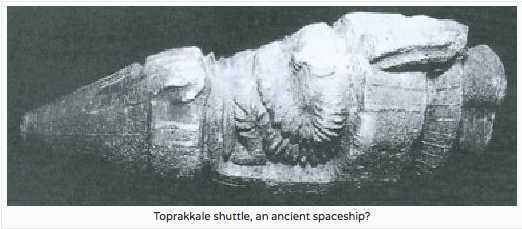Toprakkale Shuttle: An Ancient Spaceship?
SECRETS OF TOPRAKKALE – The Toprakkale shuttle is a well-known artefact among ancient astronaut investigators. Author and investigator Zecharia Sitchin traced this artifact down in a museum in Istanbul, Turkey. It was not on display, because the curators thought it was a falsification. The artefact, named after the Toprakkale site where it was found, seemed to resemble a rocketship with an astronaut sitting in it and therefore it could not be very old, so they thought.
Toprakkale, located near Lake Vani in the Caucasus region, is an extraordinary site itself.
In ancient times (9th century BC) it was known as Tushpa, the capital of the kingdom of Urartu. Tushpa was founded by the building of a fortress at the west end of the citadel of Van.
The walls of this ancient Urartian fortress, which is often simply referred to as Toprakkale, are special, because they are built with cyclopean masonry. This means that the walls are constructed without mortar, with huge stone blocks. This construction method was already legendary for the ancient Greeks, who imagined such walls could only be built by a race of giants, called Cyclopes. Cyclopean masonry is found in Europe in Mycenaean buildings, but also on other continents, for example at Machu Picchu, Peru and other pre-Columbian sites.
The fortress at Tushpa has inscriptions of the Urartian king Sarduri I, in Assyrian. Sarduri I reigned from 834 to 828 BC and is best known for moving the capital of the Urartu kingdom to Tushpa. It is remarkable that the Tuspha inscriptions, besides claiming that Sarduri I founded the site, describe the transportation of the giant blocks from a town called Alniu.
Such inscriptions usually describe conquests and victories, glorious facts about a particular ruler. Why would the writers have taken the trouble to describe a simple building process? Maybe because it was not so simple, and the writers needed to explain how the blocks, weighing up to 30 or 40 tons each and with a bulk of over 5 m³, got there?
The location of Alniu is thought to be on the north east shore of Lake Van. The blocks could not have been transported far, scholars argue. The purpose of the megalithic structure remains undetermined. Was it actually Sarduri I who built it, or is the structure much older and did he try to claim it as his own?
Is it a coincidence that at such a mysterious site, an object was found that looks like a rocketship? Zecharia Sitchin describes this object as, “A sculpted scale model of what, to modern eyes, looks like a cone-nosed rocket-ship… Powered by a cluster of four exhaust engines in the back surrounding a larger exhaust engine, the rocket-ship has room for a sole pilot-actually shown and included in the sculpture.”
Could the blocks have been transported from much further away? Using technology like rocketships to put them in place? This is just speculation of course, but why would the ancient inhabitants of Tushpa create such an artefact, if they had never seen airplanes or rocketships before?




































